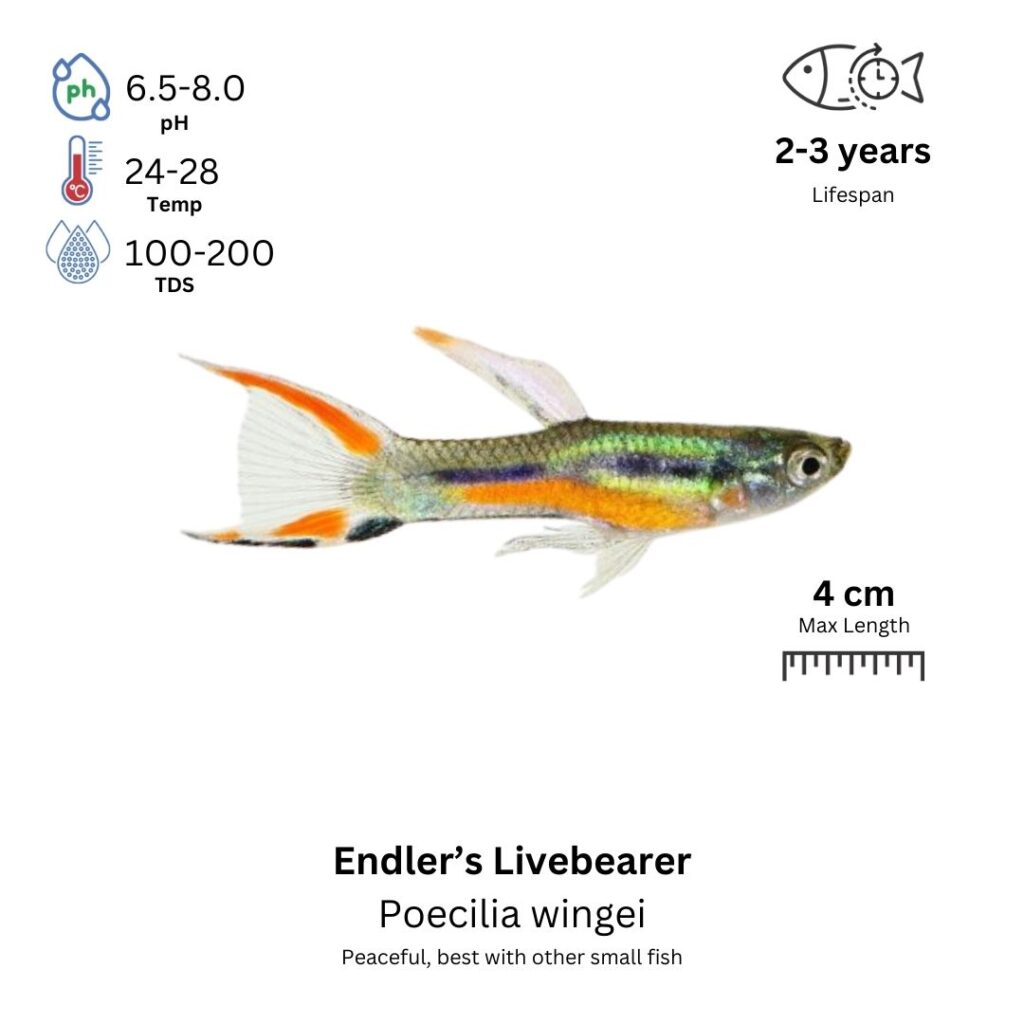Endler's Livebearer
Poecilia wingei

Description
Endler’s Livebearer is a small, colorful species of livebearer fish known for its vibrant and varied coloration. Males are particularly striking, displaying a combination of bright colors such as red, orange, blue, and green. They often have a mix of patterns, including spots, stripes, and solid colors, which can vary depending on the individual and the specific strain. Females, on the other hand, are generally more subdued in coloration, usually a pale silvery or transparent color, with a slight hint of yellow or green.
Habitat Origin
Endler’s Livebearers are native to the freshwater lakes and streams of northeastern Venezuela, particularly around the region of the Laguna de Los Patos. These fish are found in slow-moving, clear waters with moderate vegetation, where they thrive in environments that have plenty of hiding spots and soft to medium water hardness. Their natural habitat conditions include warm temperatures, slightly acidic to neutral water, and moderate water flow.
Aquarium
Ideal Number in Aquarium: At least 6 individuals, as they are schooling fish and feel more secure in groups.
Favorite Food

Endler’s Livebearers are omnivores and will accept a variety of foods. They can be fed high-quality flake food, micro pellets, and live or frozen foods such as brine shrimp, daphnia, and bloodworms. They will also graze on algae and small plant matter in the aquarium. A varied diet is important for their health and vibrant coloration.
Behavior:
Endler’s Livebearers are active and social fish that thrive in groups. They are peaceful and generally get along well with other small, non-aggressive fish. Males are particularly active, often engaging in courtship displays to attract females. These fish are also very curious and will swim around the aquarium exploring their environment. Although they are peaceful, males may become slightly territorial during breeding periods, especially around females. However, this is not typically aggressive, and they do not pose a threat to other species in the tank.
Special Care:
Endler’s Livebearers are relatively easy to care for but thrive in stable water conditions. Regular water changes, good filtration, and a well-maintained tank are essential for their well-being. They appreciate a tank with plenty of plants, where they can hide and feel secure. A soft, fine substrate is ideal, as they will often forage along the bottom for food. These fish are hardy but should be housed in a tank with gentle filtration and moderate water flow to mimic their natural environment.
Compatibility with Other Fish:
Yes, Endler’s Livebearers are compatible with many other peaceful species. They can be housed with small, non-aggressive fish like tetras, rasboras, small catfish, and peaceful cichlids. They are also compatible with shrimp and snails. Larger or more aggressive fish should be avoided, as they may stress or harm the Endler’s Livebearers. A peaceful community tank is ideal for them, where they can swim freely with other peaceful species.
Breeding Tank Setup
While Endler’s Livebearers can breed in a community tank, setting up a dedicated breeding tank is recommended to maximize fry survival and control environmental conditions. A 40–50 liter (10–13 gallon) tank is sufficient to support breeding pairs while maintaining water quality. Maintain a pH of 7.0–8.0, temperature between 24–28°C (75–82°F), and hardness around 6–12 dGH. A sponge filter or gentle internal filter provides effective filtration without endangering newborn fry. Use fine gravel or sand substrate and include Java moss, Hornwort, Anubias, and floating plants to offer cover for fry and pregnant females. Provide moderate lighting for 10–12 hours a day with some shaded spots for comfort.
Conditioning the Breeders
To prepare Endler’s Livebearers for breeding, offer a high-protein, varied diet. Include live or frozen foods like brine shrimp, daphnia, and bloodworms, and supplement with quality flakes or pellets. This improves the health and fertility of both males and females. A 20–30% water change a couple of days before breeding can stimulate spawning by mimicking natural environmental shifts. Ensure the water remains within the optimal temperature range to trigger reproductive behavior.
Breeding Process
Endler’s Livebearers are prolific and continuous breeders, often spawning without any special triggers. Males constantly display and chase females, especially during early morning or late evening hours. Females give birth to 10–40 live fry every 3–4 weeks. Since they are livebearers, there is no egg stage to worry about. It’s advisable to remove the female after giving birth to prevent her or other tankmates from eating the fry. Males can remain in the tank to continue breeding.
Fry Development & Care
Fry are born fully formed and free-swimming, usually after a 3–4 week gestation. They can immediately be fed infusoria, liquid fry food, or finely crushed flakes. After several days, introduce baby brine shrimp or microworms to promote rapid growth. Maintain clean conditions with 10–15% water changes every 2–3 days, use a sponge filter, and keep the temperature stable between 24–28°C. Avoid strong currents and aggressive tankmates that might stress or prey on the fry.
Additional Notes
Endler’s Livebearers reach breeding maturity at 3–4 months. Males are smaller and brightly colored, while females are larger, rounder, and often exhibit a gravid spot near the anal fin when pregnant. To reduce stress and maximize breeding success, avoid overcrowding, sudden water parameter changes, and aggressive species. With proper care and ideal conditions, Endler’s Livebearers can breed regularly and produce healthy generations with minimal intervention.
